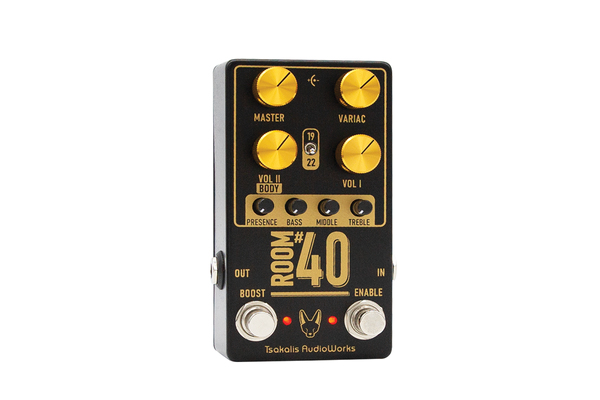Like a lot of amp-in-a-box pedals, the Room #40 from Tsakalis AudioWorks makes some pretty lofty claims. Specifically, it alleges to capture the soul and essence of a Marshall plexi and, with the flip of a switch, a JCM800, too. There’s a lot of reasons to try to replicate the sound and feel of these amps in a pedal—not least their resale values of late. I’ve played a slew of Marshall-in-a-box pedals. And while many of them deliver convincing-enough bark, they’re rarely dynamic enough to stay on my pedalboard for long. The Room #40, however, often escapes that trap and offers a lot of flexibility for matching it to changing backlines.
Jump(ered)!
While the Room #40 has more knobs than either of the amplifiers it seeks to imitate, the extra controls make the pedal more flexible and dynamic. The four larger gold dials are the meat-and-potatoes. In plexi mode (toggle up), they offer a control scheme like on the “jumpered” inputs of a plexi. Vol I acts like the treble channel and Vol II works like the normal channel. In JMP/JCM800 mode (toggle down), Vol 1 is preamp volume and Vol II adjusts the low end. Once you’ve found your desired blend, the master sets the overall output. The fourth gold knob controls the “variac” function. EVH freaks, of course, know where this is going. During Eddie’s early career, he used a Variac transformer to step down the voltage of his Marshall and craft his fabled “brown sound.” Tweaking this knob on the Room #40 has a similar effect, altering the voltage between 7.5V to 21.5V to recast the compression and attack.
The 3-band EQ along with the essential presence control helps shape high-end frequencies. The final embellishment is a dedicated boost footswitch which kicks up the gain and accentuates the mids. It’s adjustable on the back of the pedal with a screwdriver, so there’s no need to take off the backplate.
Riding the Night Train
With the Room #40 plugged into a ’60s Fender Bassman and a Gibson Les Paul, engaging the effect lends the distinctly American side of the Bassman (an amp that can sound quite Marshall-y at volume) a very British overdrive accent. Sounds from the plexi mode are robust and surprisingly complex. And plenty of bottom-end is available by cranking up Vol II. If you’ve never played a jumpered Marshall, the Room #40’s controls can take getting used to. I’d suggest leaving the EQ flat until you find the right gain profile. I tend to keep my Bassman’s bright switch engaged for a little more punch. But it wasn’t as critical with the Room #40 in the mix, and high-end frequencies I needed to add or subtract were easily handled with the #40’s presence and high-frequency controls.
“Sounds from the plexi mode are robust and surprisingly complex.”
Switching over to an Orange OR50 and a Fender Stratocaster, the Marshall flavor came through clearest and sounded most complex at lower gain settings. You can definitely hit a dirty amplifier like the Orange with the Room #40, but the crunchier OR50 clearly overshadowed some of the Room #40’s charm and capacity for detail. Yet even with less headroom, the EQ and variac provide a lot of flexibility, and the boost is an excellent means for cutting through the dirt a bit. When running with dirtier amp settings, I liked the JMP/JCM mode with a little less Vol 1 output, which makes the Room #40 function more like a glassy, sparkly lead boost, rather than just dumping more gain into the signal path. However, maxing the Vol 1 control in this context delivers tons of grindy chug, and you can use the variac to shape a punchier response. In the upper regions of the variac sweep you get more headroom and loads of that no-nonsense attack you expect from a Marshall. But it also bears mentioning that the compression from the Room#40 feels properly spongy and authentic at the right settings.
The Verdict
For the gigging musician that needs Marshall flavor for a mystery backline or a less Marshall-like tube amp, the Room #40 is a cool way to get there. It’s compact, the tones are impressive, and it will cooperate with nearly any amp thanks to a versatile EQ and presence control. If that’s not enough, the variac knob and boost features further help set this pedal apart and make the $245 price seem pretty fair.




















